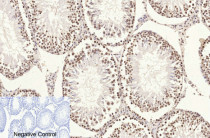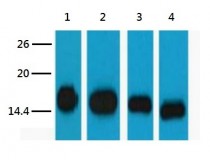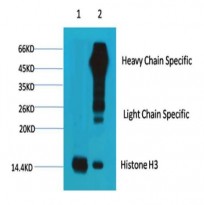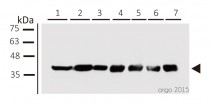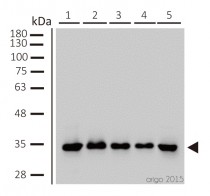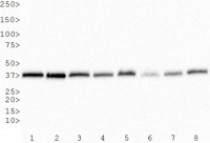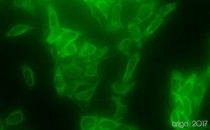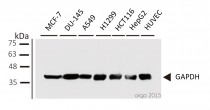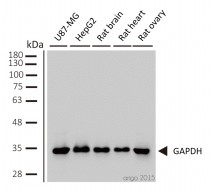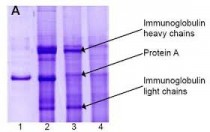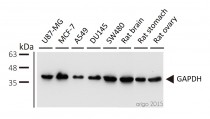ARG30267
Organelle Marker, Cytoplasm, Nucleus Antibody Duo (Histone, GAPDH)
Component
| Cat No | Component Name | Host clonality | Reactivity | Application | Package |
|---|---|---|---|---|---|
| ARG65681 | anti-Histone H3 antibody | Mouse mAb | Hu, Ms, Rat | ICC/IF, IHC-P, IP, WB | 50 μg |
| ARG10112 | anti-GAPDH antibody [6C5] | Mouse mAb | AGMK, Bb, Cat, Chk, Dog, Fsh, Hm, Hu, Mk, Ms, Pig, Rb, Rat, Xenopus laevis, Zfsh | ELISA, ICC/IF, IHC-Fr, WB | 50 μg |
Overview
| Product Description | GAPDH is often stably and constitutively expressed at high levels in most tissues and cells in cytoplasm. Therefore, GAPDH is a widely used loading control and cytoplasm marker for western blotting (35-40kDa) and Immunostaining study. Histone H3 (15-20kDa) is one of the component of nucleosomes in nucleus. So Histone H3 is one of the commonly used loading control and nucleus marker in western blotting and Immunostaining study. This Cytoplasm, Nucleus antibody Duos not only provide different MW targets for internal control selection, but also provide cytoplasm (GAPDH) and nucleus (Histone H3) markers to control the quality of cytoplasm and nucleus fractions after subcellular fractionation process and to identify the cytoplasm and nucleus position in Immunostaining study. |
|---|---|
| Target Name | Organelle Marker, Cytoplasm, Nucleus |
| Alternate Names | Organelle Marker, Cytoplasm, Nucleus antibody; GAPDH antibody; Histone H3 antibody |
Properties
| Storage Instruction | For continuous use, store undiluted antibody at 2-8°C for up to a week. For long-term storage, aliquot and store at -20°C or below. Storage in frost free freezers is not recommended. Avoid repeated freeze/thaw cycles. Suggest spin the vial prior to opening. The antibody solution should be gently mixed before use. |
|---|---|
| Note | For laboratory research only, not for drug, diagnostic or other use. |
Bioinformation
| Gene Full Name | Antibody Duo for Organelle Marker, Cytoplasm, Nucleus (Histone, GAPDH) |
|---|---|
| Highlight | Related Product: anti-Histone H3 antibody; anti-GAPDH antibody; |
Images (19) Click the Picture to Zoom In
-
ARG65681 anti-Histone H3 antibody ICC/IF image
Immunofluorescence: 100% Methanol fixed (RT, 10 min) HeLa cells stained with ARG65681 anti-Histone H3 antibody at 1:100 dilution. Left: primary antibody (green). Right: Merge (primary antibody and DAPI).
Secondary antibody: ARG55393 Goat anti-Mouse IgG (H+L) antibody (FITC)
-
ARG65681 anti-Histone H3 antibody WB image
Western blot: 20 µg of HeLa, Mouse brain and Rat brain lysates stained with ARG65681 anti-Histone H3 antibody at 1:2000 dilution.
-
ARG65681 anti-Histone H3 antibody IHC-P image
Immunohistochemistry: Paraffin-embedded Rat testis tissue stained with ARG65681 anti-Histone H3 antibody at 1:200 dilution (4°C, overnight). Antigen Retrieval: Boil tissue section in Sodium citrate buffer (pH 6.0) for 20 min. Secondary antibody was diluted at 1:200 (RT, 30 min).
Negative control was used by secondary antibody only.
-
ARG65681 anti-Histone H3 antibody IP image
Immunoprecipitation: 1) HeLa cell lysate stained with ARG65681 anti-Histone H3 antibody and 2) IP product immunoprecipitated by ARG65681 anti-Histone H3 antibody at 1:200 dilution.
-
ARG65681 anti-Histone H3 antibody WB image
Western blot: 1) HeLa, 2) Raw, 3) Mouse brain tissue, and 4) Rat brain tissue lysates stained with ARG65681 anti-Histone H3 antibody at 1:5000 dilution.
-
ARG65681 anti-Histone H3 antibody IP image
Immunoprecipitation: 1) HeLa cell lysate stained with ARG65681 anti-Histone H3 antibody and 2) IP product immunoprecipitated by ARG65681 anti-Histone H3 antibody at 1:200 dilution.
-
ARG10112 anti-GAPDH antibody [6C5] WB image
Western blot: 1) MCF-7 2) DU-145 3) A549 4) H1299 5) HCT116 6) HepG2 7) HUVEC stained with ARG10112 anti-GAPDH antibody [6C5] at 1:1000 dilution.
-
ARG10112 anti-GAPDH antibody [6C5] WB image
Western blot: 1) U87-MG 2) MCF-7 3) A549 4) DU145 5) SW480 6) rat brain 7) rat stomach 8) rat ovary stained with ARG10112 anti-GAPDH antibody [6C5] at 1:5000 dilution.
-
ARG10112 anti-GAPDH antibody [6C5] WB image
Western blot: 1) U87-MG 2) HepG2 3) rat brain 4) rat heart 5) rat ovary stained with ARG10112 anti-GAPDH antibody [6C5] at 1:2000 dilution.
-
ARG10112 anti-GAPDH antibody [6C5] WB image
Western blot: pAFs, AcoSV40, and AcoSI-1 stained with ARG10112 anti-GAPDH antibody [6C5] at 1:5000 dilution.
From Michele N Dill et al. PLoS One. (2023), doi: 10.3389/fcell.2022.899869, Fig. 2. C.
-
ARG10112 anti-GAPDH antibody [6C5] WB image
Western blot: Porcine kidney stained with ARG10112 anti-GAPDH antibody [6C5].
From Jianni Huang et al. Front Cell Dev Biol (2022), doi: 10.3389/fcell.2022.899869, Fig. 2. E.
-
ARG10112 anti-GAPDH antibody [6C5] WB image
Western Blot: 1) HeLa, 2) NTERA-2, 3) A-431, 4) HepG2, 5) MCF-7, 6) NIH 3T3, 7) PC-12 and 8) COS-7 whole cell lysates stained with anti-GAPDH antibody [6C5] (ARG10112)
-
ARG10112 anti-GAPDH antibody [6C5] ICC/IF image
Immunofluorescence: 100% Methanol fixed (RT, 10 min) HeLa cells stained with ARG10112 anti-GAPDH antibody [6C5] (green) at 1:200 dilution.
Secondary antibody: ARG55393 Goat anti-Mouse IgG (H+L) antibody (FITC)
-
ARG10112 anti-GAPDH antibody [6C5] WB image
Western blot: Mouse samples stained with ARG10112 anti-GAPDH antibody [6C5] at 1:1000 dilution.
From Yun-Yun Li et al. Int J Biol Sci (2022), doi: 10.7150/ijbs.68224, Fig. 5. C.
-
ARG10112 anti-GAPDH antibody [6C5] WB image
Western blot: 1) MCF-7 2) DU-145 3) A549 4) H1299 5) HCT116 6) HepG2 7) HUVEC stained with ARG10112 anti-GAPDH antibody [6C5] at 1:1000 dilution.
-
ARG10112 anti-GAPDH antibody [6C5] WB image
Western blot: 1) U87-MG 2) HepG2 3) rat brain 4) rat heart 5) rat ovary stained with ARG10112 anti-GAPDH antibody [6C5] at 1:2000 dilution.
-
ARG10112 anti-GAPDH antibody [6C5] WB image
Western blot: HUVEC stained with ARG10112 anti-GAPDH antibody [6C5].
From Bingzheng Lu et al. Oxid Med Cell Longev (2020), doi: 10.1155/2020/2048210, Fig. 5. B.
-
ARG10112 anti-GAPDH antibody [6C5] IP image
Immunoprecipitation and western blot: 1) GAPDH (1 μg). 2) GAPDH IP from rat heart tissue extract. 3) Only GAPDH preincubated with Protein A Sepharose. 4) Only Protein A Sepharose stained with ARG10112 GAPDH antibody [6C5].
Mixture of protein A-Sepharose with ARG10112 anti-GAPDH and tissue extract was incubated for 30 min at room temperature and precipitated by centrifugation. Pellet was washed with PBS, suspended in reducing electrophoresis sample buffer and heated for 5 minutes at 100ºC. After centrifugation supernatant was loaded on gel and proteins were separated by SDS electrophoresis. -
ARG10112 anti-GAPDH antibody [6C5] WB image
Western blot: 1) U87-MG 2) MCF-7 3) A549 4) DU145 5) SW480 6) rat brain 7) rat stomach 8) rat ovary stained with ARG10112 anti-GAPDH antibody [6C5] at 1:5000 dilution.
Specific References


